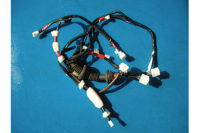On the assembly line, every medical device is thoroughly checked for quality and functionality. Are all the parts present? Is the needle sharp? Does the device leak? Does air flow where, when and how it’s supposed to? Do triggers and control knobs function correctly? Does the touch screen work?
Even before a medical device gets to mass-production, it must undergo a slew of tests for safety and efficacy. Does the device do what was intended? Are its components and materials inherently safe?
The latter question is addressed through biocompatibility testing and risk evaluation. The goal of biocompatibility testing is to prevent adverse reactions from using a medical device. For example, the adhesive in a bandage might irritate the skin, or a chemical used to formulate a plastic part for an implant might turn out to cause cancer.
Biocompatibility testing is done on the final device design, rather than parts or prototypes. Testing must be done on the fully assembled, packaged and sterilized device.
The international standard covering biocompatibility evaluation of medical devices is ISO 10993, a series of 20 documents, or chapters, covering everything from how to perform specific tests for carcinogenicity to how to manage the welfare of lab animals.
The first chapter, ISO 10993-1, provides an overview of biocompatibility and a recommended approach for mitigating the biological risks associated with the materials used in medical devices and the methods of processing those materials. The Food and Drug Administration (FDA) generally recognizes ISO 10993 for medical devices submitted for market clearance, and in June 2016, the agency released a guidance document on how it recommends ISO 10993-1 be applied.
Standard Revised
The fifth edition of ISO 10993-1 was published in August 2018 and replaces the 2009 version of the standard.
“The document has about doubled in size from the previous version,” says Christopher Parker, associate department head for in-vivo biocompatibility testing and shared services at Toxikon Corp., a medical device testing company in Bedford, MA. “A lot of that is just expanding on concepts from the previous version, and incorporating recommendations from the FDA’s guidance document.”
However, the revised standard also contains new information that medical device manufacturers should be aware of. For example, ISO 10993-1:2018 contains recommendations for evaluating the biocompatibility of nanomaterials, which weren’t commercially available in 2009. The revision contains new recommendations for assessing the risk of transient contact with a medical device, as when a needle punctures the skin and is immediately removed. And, the revision includes new guidance on reusable devices.
“The new standard also offers more information about indirect contact,” says Rob Packard, president of Medical Device Academy Inc., a training and consulting firm that helps manufacturers get new medical devices approved by various regulatory agencies. “For example, if you breathe through a respirator, you are breathing in air that has come into contact with various materials. Could that air now contain chemicals that might be harmful to the lungs?”
The biggest change in the standard is much broader than any of that, however. It fundamentally changes how manufacturers evaluate biocompatibility of medical devices.
In the past, manufacturers were required to perform certain biocompatibility tests based on the type of device and how it contacts the body. “A product that touches intact skin is treated differently from a product that touches a wound,” explains Packard. “A device that goes inside the mouth would be different than a device that is implanted inside the body.”
The duration of the contact is also important. Does the device contact the body for less than 24 hours? Less than 30 days? Or is it 30 days or more? “The standard also considers cumulative use,” says Packard. “A good example is hemodialysis. A hemodialysis treatment typically lasts about four hours—but it has to be done three times per week for the rest of your life, unless you get a kidney transplant. Therefore, the long-term impact is quite significant.”
The previous standard contained a large table that lists what tests manufacturers had to do based on the type of device, the type of contact, and the duration of contact. The new standard is less rigid and may even enable manufacturers to skip some biocompatibility tests altogether—as long as they can provide solid evidence for doing so.
“Now, every test is pretty much optional,” says Packard. “Instead of checking off tests on a table, manufacturers have to perform chemical and physical characterizations of their products, and then, based on that analysis, decide which tests are appropriate.
“They might come up with the same answers as the table, but they might also be able to say, ‘We’ve already done an extractables and leachables study on this material, and it has a good safety record for this kind of contact, so we’re not going to retest it.’
“The standard gives manufacturers a way to justify not testing based on the chemical characterization of their product. The idea is to save lab animals and avoid needless testing to prove, once again, that established materials like polyurethane, polyethylene, polypropylene and titanium are safe. That doesn’t mean you wouldn’t do any testing. It just means you might reduce how much testing you had to do.”
“The checkbox mentality just doesn’t work anymore,” adds Thor Rollins, director of toxicology, extractables and leachables at Nelson Laboratories LLC, a medical device testing firm in Salt Lake City. “Medical devices are getting much more complicated and unique, so unique evaluation methods are needed.
“The problem with the past approach is that engineers never really had to understand the materials and processes they were putting into their devices. All they had to do was pass some antiquated tests and hope that they screened for safety.”
Reducing the amount biocompatibility testing that must be performed on a product is no small thing. The process can be long and costly. For most medical devices, the process can take 10 to 12 weeks and cost $15,000. For an implant, which might require acute, subacute and chronic systemic toxicity testing, the process might take six to nine months and cost $100,000.
Indeed, it’s precisely because of the cost and time-consuming nature of biocompatibility testing that medical device manufacturers hesitate to adopt new materials.
Rather than mandate testing, the standard advises manufacturers to do a thorough chemical and physical risk assessment of their devices.
“We still get asked, ‘What tests do we have to do?’” says Parker. “But, that’s no longer the right question. Years ago, you just did your testing, got your end-points, and submitted for approval. Now, the question is, ‘What does the risk assessment tell us to do?’ Maybe you don’t have to do testing.”
The risk assessment should consider not just the base materials, but how they’re processed. For example, engineers must evaluate the base plastic, but also additives and adjuncts, such as plasticizers, colorants, mold release agents, detergents and adhesives. Risk assessment can encompass the geometry of the device, the effects of transportation and aging, and other factors.
“Where companies get into trouble is with [materials they don’t think about],” says Packard. “For example, if an epoxy is used to encapsulate a circuit board inside a respirator, and if air flows over the epoxy and into the patient’s lungs, now you could have an issue.”
Risk assessment doesn’t end with the patient, either. Engineers may need to consider the biological risks to the clinicians handling the device, too.
Waiting on the FDA
While the FDA participated in drafting ISO 10993-1:2018, it does not necessarily agree with everything in the document. The FDA has begun the review process for the new standard, but a new guidance document is not expected until April 2019. In the meantime, manufacturers should continue to follow the agency’s 2016 guidance document on ISO 10993-1.
“The new version of ISO 10993-1 is more like the FDA guidance on the old standard than it’s like the old standard, so if manufacturers are compliant with FDA guidance, they’re close to what the new standard says anyway.”
Regardless of what the FDA has to say about ISO 10993-1:2018 later this year, engineers are well-advised to choose materials for their devices carefully and to consider biocompatibility requirements early in the design stage.
“Engineers have to be a little more knowledgeable in their material choices and how they design their products,” counsels Packard. “If they wait until the design is finalized before thinking about biocompatibility testing, they’re going to run into problems. I’ve actually had to redesign a spinal implant completely from scratch because of biocompatibility issues.”


















